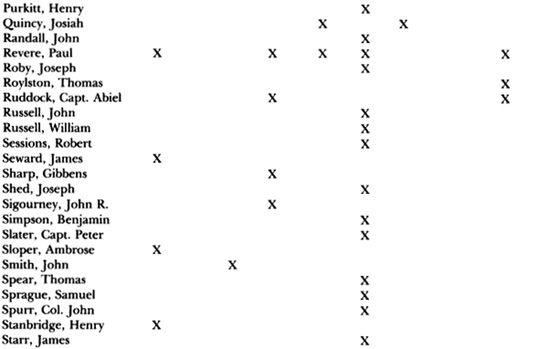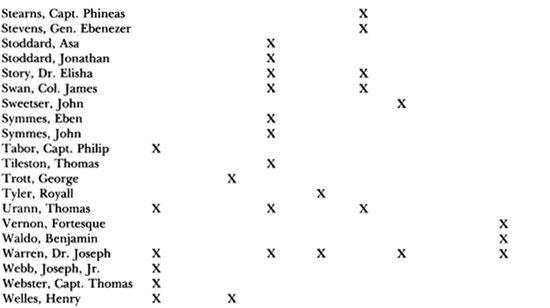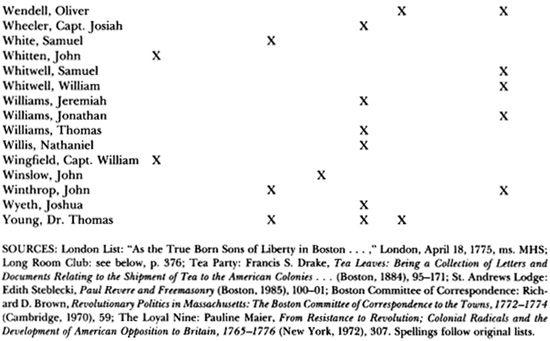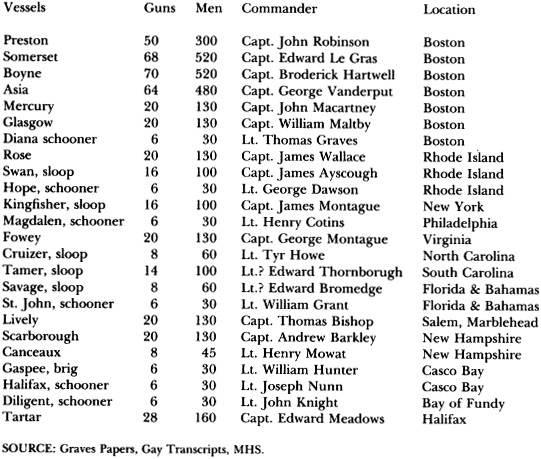Paul Revere's Ride (53 page)
Read Paul Revere's Ride Online
Authors: David Hackett Fischer
Tags: #General, #Biography & Autobiography, #History, #United States, #Historical, #Revolutionary Period (1775-1800), #Art, #Painting, #Techniques




APPENDIX E
 The British Army in Boston: Order of Battle, April 18, 1775
The British Army in Boston: Order of Battle, April 18, 1775
Commander in Chief and Staff
Lieutenant General the Hon. Thomas Gage (Colonel, 22nd Foot), commander in chief Major General Frederic Haldimand (Colonel commandant, 2nd Battalion, 60th, or Royal
American Regiment), second in command
Col. James Robertson, Barrack Master General
Major Stephen Kemble, Deputy Adjutant General
Major William Shirreff, Deputy Quartermaster General
Lieut. Harry Rooke, 4th foot, Aide de Camp
Capt. Brehm, Aide de Camp
Capt. Oliver De Lancey, 17th Light Dragoons, Aide de Camp
Samuel Kemble, Esqr., Confidential Secretary
1st Brigade
Brigadier: the Rt. Hon. Hugh, Earl Percy (Colonel, 5th Foot)
Brigade Major: Captain Thomas Moncrieffe (59th Foot)
4th Regiment of Foot, or the King’s Own (Lt. Col. George Maddison)
23rd Regiment of Foot, or the Royal Welch Fusiliers (Lt. Col. Benjamin Bernard)
47th Regiment of Foot (Lt. Col. William Nesbitt)
1st Battalion, British Marines (Major John Pitcairn)
2nd Brigade
Brigadier: Robert Pigot (Lt. Col., 38th Foot)
Brigade Major: Captain John Small (21st Foot)
5th Regiment of Foot (Col. the Hon. Hugh Earl Percy)
38th Regiment of Foot (Lt. Col. Robert Pigot)
52nd Regiment of Foot (Lt. Col. Valentine Jones)
3rd Brigade
Brigadier: Valentine Jones (Lt. Col., 52nd Foot)
Brigade Major: Captain Francis Hutchinson (60th, or Royal American Regiment)
10th Regiment of Foot (Lt. Col. Francis Smith)
43rd Regiment of Foot (Lt. Col. George Clerk)
59th Regiment of Foot (Lt. Col. Ortho Hamilton)
18th Regiment of Foot, 3 companies (Capt. John Shea)
65th Regiment of Foot, 2 companies (senior officer unknown)
Troops not brigaded
64th Regiment of Foot (Lt. Col. the Hon, Alexander Leslie)
in garrison, Castle William, Boston harbor
4th Battalion, Royal Regiment of Artillery (Col. Samuel Cleveland)
35 Battery (Capt. William Martin)
38 Battery (Capt. Lt. W. Orcher Huddlestone)
39 Battery (Capt. Anthony Farrington)
42 Battery (Capt. Lt. Robert Fenwick)
British Marines, shipboard detachments (Adm. Samuel Graves)
Royal Engineers (Capt. John Montresor)
SOURCES: Thomas Gage, Distribution of His Majesty’s Forces in America,” July 19, 1775,
Gage Correspondence,
II, 690; Gage to Richard Rigby, July 8, 1775, with enclosure, “List of General and Staff Officers on the Establishment in North America, from 25th December 1774 to 24th June, 1775,”
ibid.,
II, 687-89; Vincent J.-R. Kehoe, “We Were There!” April 19, 1775 (mimeographed typescript, 1974), vol. I,
11-27; Barker,
British in Boston,
9, 11; Mackenzie,
Diary,
I, 8; Regimental Rosters, Muster Books and Pay Lists, W012/2194-7377, PRO.
APPENDIX F
 The British Army in Boston: Returns of Strength, 1775
The British Army in Boston: Returns of Strength, 1775
These returns do not include commissioned officers, sergeants and musicians. The normal complement for an infantry regiment was 1 lieutenant colonel, 1 major, 8 captains, 20 lieutenants, 1 adjutant, 1 quartermaster, 1 surgeon, 1 surgeon’s mate, 1 chaplain (4th and 10th regiment only), 20 sergeants, and 12 fifes and drums. Only corporals and privates were counted in these estimates of “rank and file.” The normal complement of corporals was three to a company at full strength.

APPENDIX G
 The Royal Navy in America, January 1, 1775
The Royal Navy in America, January 1, 1775
Admiral Samuel Graves’s “List of the North American Squadron, on the 1st of January 1775”

APPENDIX H
 Weather Patterns, April 17-20, 1775
Weather Patterns, April 17-20, 1775
The weather on the day of the battle has been described by historians in contradictory ways. Hudson writes, “All accounts agree that the day was unusually warm for that season of the year” (
Lexington,
197). Murdock disagrees. “Contrary to general belief,” he writes, “the 19th of April seems to have been a cold, windy day, with a bright sun … evidently the wind was east”
(The Nineteenth of April, 1775,
55). Both of these statements are incorrect.
The New England weather was typically volatile in this period. The 18th of April was wet through the day, followed by rapid clearing at night. Winds were variable, veering from the northeast to the south. The following diary entries were recorded for this day:
“rain” by Nathaniel Ames, Dedham; a “fine rain” by Jonas Clarke in Lexington; “rainy most of the day” by Joseph Andrews; “rain a.m. fair towards night by Ebenezer Gay of Suffield, Conn. An anonymous Concord weather diary records “rain” in the morning and “showers” in the afternoon, with a south wind. Jeremy Belknap in Dover, N.H., described the 17th of April as “fair” and “warm,” with small showers in the afternoon and rain with a northeasterly wind at night, and the 18th as “warm rain pm cloudy.”
